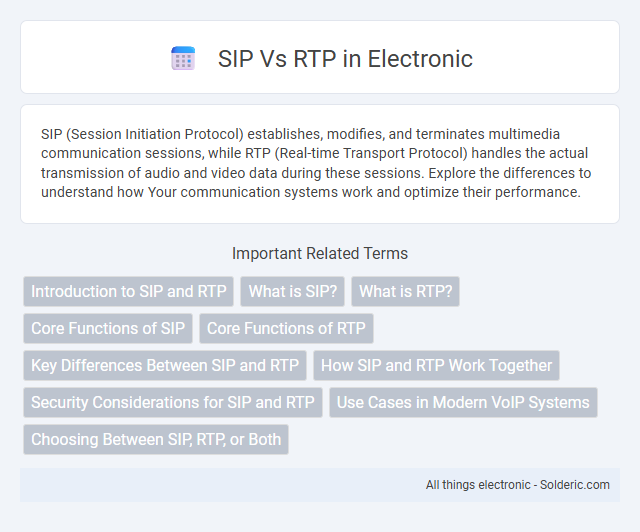SIP (Session Initiation Protocol) establishes, modifies, and terminates multimedia communication sessions, while RTP (Real-time Transport Protocol) handles the actual transmission of audio and video data during these sessions. Explore the differences to understand how Your communication systems work and optimize their performance.
Comparison Table
| Feature | SIP (Session Initiation Protocol) | RTP (Real-time Transport Protocol) |
|---|---|---|
| Purpose | Initiates, modifies, and terminates multimedia sessions | Transports real-time audio and video data |
| Protocol Type | Signaling protocol | Transport protocol |
| Layer | Application layer | Transport layer (built on UDP) |
| Function | Session establishment and control | Delivery of media streams |
| Transport | Typically uses UDP, TCP, or TLS | Uses UDP only |
| Media Handling | Does not handle media data directly | Encapsulates and delivers media packets |
| Standard | Defined in RFC 3261 | Defined in RFC 3550 |
| Security | Supports SIP over TLS for encryption | Can use SRTP for secure media transport |
| Use Case | VoIP call setup and control | Real-time audio/video streaming |
Introduction to SIP and RTP
Session Initiation Protocol (SIP) is a signaling protocol used to establish, modify, and terminate multimedia communication sessions such as voice and video calls over IP networks. Real-Time Transport Protocol (RTP) is responsible for delivering audio and video data during these sessions, providing end-to-end network transport functions suitable for real-time applications. SIP manages the control and setup of communication sessions, while RTP handles the actual transmission of media streams within those sessions.
What is SIP?
SIP (Session Initiation Protocol) is a signaling protocol used to initiate, manage, and terminate real-time communication sessions such as voice, video, and messaging over IP networks. It establishes the parameters for multimedia calls while coordinating the setup and control between endpoints. Your communication devices rely on SIP to negotiate and maintain connections before RTP (Real-time Transport Protocol) handles the actual media transmission.
What is RTP?
RTP (Real-time Transport Protocol) is a network protocol designed for delivering audio and video over IP networks, primarily used in VoIP communications. It works alongside SIP (Session Initiation Protocol), which handles signaling and session control, while RTP manages the actual media stream transmission. Your VoIP system relies on RTP to ensure smooth, real-time delivery of voice and video data during calls.
Core Functions of SIP
SIP (Session Initiation Protocol) handles the establishment, modification, and termination of multimedia communication sessions such as VoIP calls. It manages signaling tasks including user location, call setup, authentication, and session negotiation. Unlike RTP, which transports the actual media streams, SIP is responsible for orchestrating the communication parameters and session control.
Core Functions of RTP
RTP (Real-time Transport Protocol) is primarily responsible for delivering audio and video over IP networks with real-time characteristics, enabling synchronized and timely media streaming essential for VoIP and video conferencing. Unlike SIP, which handles signaling and session management, RTP manages the actual transport of multimedia data packets, including sequencing, timing, and payload identification. Understanding RTP's core functions ensures your communication system maintains high-quality media transmission with minimal latency and jitter.
Key Differences Between SIP and RTP
SIP (Session Initiation Protocol) primarily handles signaling and control for establishing, modifying, and terminating multimedia communication sessions, while RTP (Real-time Transport Protocol) is responsible for the actual transmission of audio and video data during those sessions. SIP manages call setup, user location, and session management, whereas RTP ensures timely delivery, sequencing, and synchronization of real-time media streams. The two protocols work together in VoIP systems, where SIP initiates calls and RTP carries the voice or video packets across the network.
How SIP and RTP Work Together
SIP (Session Initiation Protocol) manages the signaling and control of multimedia communication sessions, establishing, modifying, and terminating calls. RTP (Real-time Transport Protocol) transmits the actual audio and video data streams once the session is set up by SIP. Together, SIP ensures your call connects correctly while RTP delivers continuous, real-time media for seamless communication.
Security Considerations for SIP and RTP
SIP (Session Initiation Protocol) relies heavily on TLS (Transport Layer Security) to protect signaling messages from eavesdropping, tampering, and impersonation, ensuring robust security during session establishment. RTP (Real-time Transport Protocol) security depends primarily on SRTP (Secure RTP) to encrypt and authenticate voice or video media streams, preventing interception and replay attacks. Your communication infrastructure must implement both SIP over TLS and SRTP to maintain confidential and integrity-protected VoIP calls.
Use Cases in Modern VoIP Systems
SIP (Session Initiation Protocol) primarily manages call setup, modification, and termination in modern VoIP systems, enabling seamless communication initiation across devices. RTP (Real-Time Transport Protocol) handles the real-time transmission of voice and video data once the session is established, ensuring synchronized and low-latency media delivery. Together, SIP and RTP form the core framework for efficient VoIP communications, supporting services such as IP telephony, video conferencing, and unified communications platforms.
Choosing Between SIP, RTP, or Both
SIP (Session Initiation Protocol) manages signaling and control for establishing, modifying, and terminating multimedia sessions, while RTP (Real-time Transport Protocol) handles the actual transmission of audio and video data during those sessions. Choosing between SIP, RTP, or both depends on your communication needs: SIP is essential for session setup and management, whereas RTP is required to deliver media streams in real-time. For a complete VoIP or video conferencing solution, integrating both protocols ensures reliable call signaling alongside efficient media transport.
SIP vs RTP Infographic

 solderic.com
solderic.com